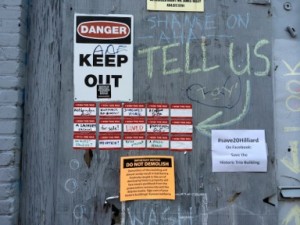New tools, old tactics deployed to save a historic Atlanta Building
17 September 2014 – David Rotenstein
preservation, advocacy, public engagement, community history, media, sense of place, publicity, economic development, politics
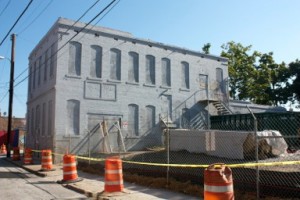
Former Trio Laundry Dry Cleaning Building, 20 Hilliard Street, Atlanta, Ga. Photo credit: David Rotenstein
Earlier this year The New York Times dubbed Atlanta, Ga., “the city too busy to remember.” The play on Civil Rights-era mayor Ivan Allen’s municipal sobriquet came during reporting on Atlanta’s demolition of a historic African American church, Friendship Baptist, to clear the way for new stadium construction. In the two weeks leading up to Labor Day weekend, a handful of historic preservation activists demonstrated to city officials that not everyone in Atlanta was too busy to remember the past and its architecture. Preservationists combined old-school tactics with information-age networks to win a reprieve for a city-owned early 20th-century industrial building.
The two-story brick former Trio Laundry Dry Cleaning Building is located in Atlanta’s gentrifying Old Fourth Ward neighborhood, home to the Martin Luther King Historic Site and the city’s storied Sweet Auburn historic district. It was constructed in 1910 in a light industrial zone that included a shoe factory, mattress manufacturers, and machine works. The Trio Steam Laundry Company was founded around the turn of the 20th century and was Atlanta’s first large-scale commercial laundry business.
Freeway construction in the 1960s separated the Old Fourth Ward from downtown. Desegregation, black flight, and disinvestment sent the neighborhood into an economic tailspin in the 1970s and 1980s. Proximity to sites commemorating Martin Luther King, Jr. and the new Atlanta BeltLine trail helped renew interest in the neighborhood after the turn of the 21st century. Economic and community development projects include a new streetcar line, mixed-use developments, and business incubators.
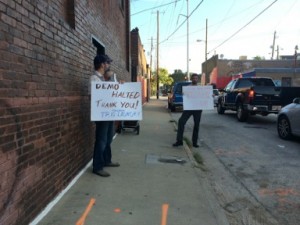
Preservationists across from the Trio building during morning rush hour one day after Atlanta’s mayor announced demolition would end. Photo credit: David Rotenstein
Gentrification and displacement have accompanied the Old Fourth Ward’s rediscovery. The journalist Nathan McCall chronicled neighborhood tensions amid the changing socioeconomic landscape in his 2007 novel, Them (Atria Books). Although there had been local historic preservation efforts since the 1970s, new interest in old buildings and spaces has been sparked by the changes tied to gentrification. Uneven development throughout the Old Fourth Ward includes the elimination of public housing, ambitious new construction projects in addition to adaptive reuse, and the speculative “banking” of properties for possible future sale.
The Trio laundry company’s original building in the district was individually listed in the National Register of Historic Places in 1997, and it has become a local adaptive use success story–it was transformed into the Brushworks Lofts. Built several years later across the street, the 1910 building is listed as a contributing property to local and National Register historic districts. It was privately owned until 2009 when the Atlanta Housing Authority bought the long-vacant building from a local developer.
As a federally-funded municipal agency, the AHA was required to comply with Section 106 of the National Historic Preservation Act. Documents released by Atlanta preservationists show that the building was in an advanced state of disrepair when the AHA acquired it. Advocates alleged in social media and in interviews that the city’s lack of maintenance had contributed to what is sometimes called “demolition by neglect.” Complicating matters for redevelopment and preservation were soils contaminated by decades of dry cleaning at the site.
In late 2013 the AHA began the process to secure the required regulatory approvals for demolition. The agency declared the building unsafe and as required under the US Department of Housing and Urban Development (HUD) regulations, it entered into consultation with the Georgia state historic preservation office about the fate of the building. AHA also obtained a staff-level demolition approval from the city’s historic preservation review authority, the Atlanta Urban Design Commission.
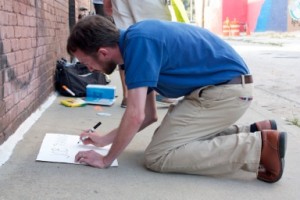
Preservation architect Kyle Kessler, one of the leaders who helped stop the demolition, makes his sign for the August 29 victory celebration. Photo credit: David Rotenstein
Preservationists mobilized in late August 2014 after a resident alerted community leaders to demolition equipment and a new fence around the site. Emails began flying, posts on an Atlanta Preservation Professionals Facebook page appeared, and bloggers began writing about the impending demolition. A Trio Laundry Twitter account was created (@LaundryTrio) along with a new Facebook page, “Save the Historic Trio Building.” Tweets with the #Save20Hilliard hashtag began circulating, many directed to Atlanta’s mayor, US Rep. John Lewis, and other community leaders. Stories appeared in the Saporta Report and Creative Loafing and elsewhere. Local TV and radio stations aired segments on the building.
The AHA stopped demolition work after gutting the building’s interior and after parts of the brick cornice had been removed. On August 26, Atlanta Mayor Kasim Reed responded to a tweet from the @LaundryTrio account: “We are listening.” An AHA press release soon appeared:
The Atlanta Housing Authority, following an outcry from city residents and historic preservationists, announced that it is halting demolition of the structure at 20 Hilliard Street in order to reassess if it is possible to salvage the structure.
“This was no accidental campaign,” wrote Charles Lawrence, a conservator with a local architecture firm and founder of the Atlanta Preservation Professionals Facebook group in a post about the Trio building. “The strategies and tactics used to get the attention of press and politicians are time tested. Social media is a powerful tool, and so too are phone calls, texts, and letters.”
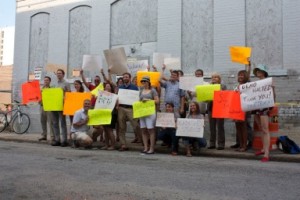
Preservationists and community activists gathered in front of the Trio building August 29, 2014. Photo credit: David Rotenstein
Preservationists and community activists gathered at the site the Friday before Labor Day to celebrate. They made signs expressing their wishes for the future of the building–affordable housing, a jobs training site, a market–and they posed for a group photo.
Earlier in the day, Lawrence wrote on Facebook that the group’s work wasn’t finished. In fact, in his opinion, it was just starting. “Even with this success (or partial success, as it is too soon to know if the Trio can be saved), we need a stronger framework for advocacy,” Lawrence noted.
Atlanta, like every other American city, has had its preservation wins and losses. Preservationists in the 1970s successfully saved downtown’s Fox Theatre and anti-road activists chained themselves to trees in the 1980s to prevent an expressway from being built through some of the city’s oldest “streetcar suburbs.”
But, as The New York Times aptly noted in its coverage of the demolition of Friendship Baptist Church, Atlanta has a reputation for destroying its past to make way for the future. Locally, this legacy was characterized by Emory University archivist Randy Gue. “Atlanta’s history has been remade every 40 years or so,” Gue in March 2014 told the Atlanta online news site, the Saporta Report in an article on preserving the Fox Theatre.
One week after demolition was stopped, preservationists reported in social media posts that city officials had abandoned plans to demolish the building. A September 8, 2014, post on the Save the Historic Trio Building Facebook page informed readers that stabilization plans had been completed and were under review by city and state officials. Local preservationists have seized upon the victory as a way to reverse the trend so aptly described in the Times article and by Emory University’s Gue.
But ongoing development pressures and struggles to maintain public support and investment for affordable urban spaces make the future of buildings like this one uncertain. What would it take to create a movement for more enduring and sustainable preservation in dialogue with those concerns about affordability, social and racial justice, and community memory?
~ David S. Rotenstein is an Atlanta-based consulting historian. He can be found on Twitter @iVernacular, and he blogs at http://blog.historian4hire.net/




